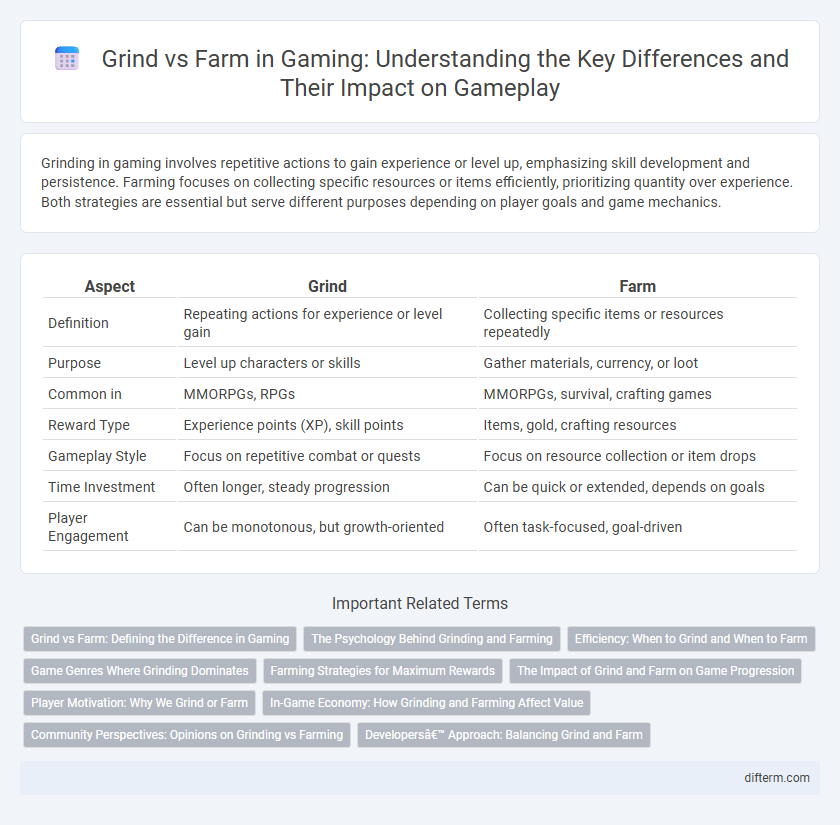Grinding in gaming involves repetitive actions to gain experience or level up, emphasizing skill development and persistence. Farming focuses on collecting specific resources or items efficiently, prioritizing quantity over experience. Both strategies are essential but serve different purposes depending on player goals and game mechanics.
Table of Comparison
| Aspect | Grind | Farm |
|---|---|---|
| Definition | Repeating actions for experience or level gain | Collecting specific items or resources repeatedly |
| Purpose | Level up characters or skills | Gather materials, currency, or loot |
| Common in | MMORPGs, RPGs | MMORPGs, survival, crafting games |
| Reward Type | Experience points (XP), skill points | Items, gold, crafting resources |
| Gameplay Style | Focus on repetitive combat or quests | Focus on resource collection or item drops |
| Time Investment | Often longer, steady progression | Can be quick or extended, depends on goals |
| Player Engagement | Can be monotonous, but growth-oriented | Often task-focused, goal-driven |
Grind vs Farm: Defining the Difference in Gaming
Grind in gaming refers to repetitive tasks aimed at leveling up a character or unlocking achievements, often requiring significant time investment and skill. Farming specifically targets the collection of in-game resources or items, optimizing efficiency through repeated actions to accumulate materials or currency. Understanding the distinction between grind and farm helps players strategize their gameplay for progression and resource management.
The Psychology Behind Grinding and Farming
Grinding and farming in gaming tap into different psychological motivators: grinding appeals to the desire for mastery and long-term achievement through repetitive challenges, while farming satisfies the need for resource accumulation and immediate rewards. Players often experience a dopamine-driven cycle of anticipation and reward, where grinding builds skill and progression, whereas farming provides tangible in-game benefits that foster a sense of control and purpose. Understanding these psychological drivers helps developers design more engaging gameplay loops that balance motivation and player retention.
Efficiency: When to Grind and When to Farm
Grinding focuses on repetitive, high-intensity activities to quickly gain experience or items but often demands significant time and energy investments, making it efficient for rapid leveling during peak play sessions. Farming involves slower, sustained collection of resources or rare drops in low-risk environments, optimizing efficiency when balancing gameplay with other commitments or aiming for specific resource accumulation. Prioritizing grinding or farming depends on your current goals, time availability, and the in-game economy dynamics to maximize overall progress and resource acquisition.
Game Genres Where Grinding Dominates
In MMORPGs and RPGs, grinding dominates as players often repeatedly defeat enemies or complete quests to steadily increase experience points and level up characters. Action RPGs also emphasize grinding through continuous combat and item collection to enhance skills and gear. These genres rely heavily on repetitive tasks, distinguishing grinding from farming, which focuses more on resource gathering or item accumulation.
Farming Strategies for Maximum Rewards
Effective farming strategies in gaming focus on optimizing resource collection through efficient routes and target prioritization, minimizing downtime, and maximizing yield per effort. Utilizing tools such as automation scripts, in-game buffs, and high-drop rate zones significantly increases the quantity and quality of rewards gathered. Consistent farming routines combined with adapting to game updates and market trends ensure sustained progress and competitive advantage.
The Impact of Grind and Farm on Game Progression
Grind and farm mechanics significantly influence game progression by affecting player engagement and time investment. Grinding often requires repetitive tasks to gain experience or levels, enhancing skill mastery but potentially leading to burnout. Farming focuses on resource accumulation, enabling faster upgrades and crafting, which accelerates advancement but may reduce gameplay variety.
Player Motivation: Why We Grind or Farm
Player motivation in gaming revolves around the psychological satisfaction derived from grind and farm mechanics, where grinding involves repetitive skill-based tasks to achieve progression, and farming emphasizes resource collection through repeated actions. Both approaches tap into players' intrinsic desires for achievement, mastery, and competition, as well as extrinsic rewards such as rare items or in-game currency. Understanding these motivations helps developers design engaging systems that balance challenge and reward to maintain player retention and satisfaction.
In-Game Economy: How Grinding and Farming Affect Value
Grinding typically involves repetitive actions that yield experience points or resources slowly, maintaining a stable in-game economy by controlling inflation. Farming, on the other hand, often targets high-yield resource spots or rare items, which can flood the market and reduce item value if done excessively. Balancing grinding and farming activities is crucial in preserving the scarcity and demand that drive player-driven economic systems.
Community Perspectives: Opinions on Grinding vs Farming
Community perspectives on grinding versus farming in gaming vary widely, with grinders valuing the challenge and skill development involved in repetitive tasks, while farmers prioritize efficiency and resource accumulation. Online forums reveal that grinders often emphasize personal achievement and mastery, whereas farmers highlight the practical benefits of rapid progress and economic gain within the game. These differing opinions shape player strategies and influence game design, impacting player retention and in-game economies.
Developers’ Approach: Balancing Grind and Farm
Developers strategically balance grind and farm mechanics to enhance player engagement while minimizing frustration in game design. By adjusting resource availability and reward frequency, they create a dynamic environment that caters to both casual players and dedicated grinders. Data shows that this balance directly impacts player retention rates and overall satisfaction within MMORPGs and mobile games.
grind vs farm Infographic

 difterm.com
difterm.com